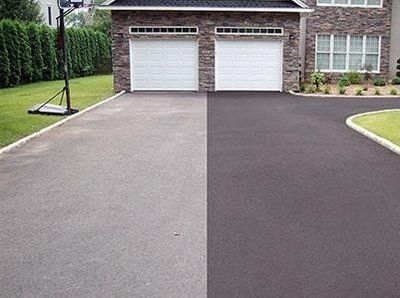Elevate Commercial Charm: Hot Mix Asphalt Sealing for Angled Parking Lots
Elevate Commercial Charm: Hot Mix Asphalt Sealing for Angled Parking Lots
Blog Article
Hot Mix Asphalt: A Lasting Remedy for Sidewalk
Hot Mix Asphalt (HMA) has actually emerged as a leading lasting option for pavement options, providing a myriad of ecological benefits and innovative modern technologies. As the need for environment-friendly construction techniques grows, exploring the subtleties of HMA's sustainability can offer valuable understandings into the future of sidewalk services.
Environmental Advantages of Hot Mix Asphalt

Furthermore, Warm Mix Asphalt helps to alleviate urban warm island effects. Its dark shade soaks up sunlight, reducing the amount of warmth reflected back right into the ambience compared to lighter-colored sidewalks. This can reduce ambient temperature levels in urban locations, lowering the demand for cooling and ultimately minimizing power usage.
In addition, Hot Mix Asphalt adds to boosted stormwater monitoring. Its porous nature allows water to infiltrate the pavement and charge groundwater products, reducing runoff and the risk of flooding. These environmental benefits make Hot Mix Asphalt a sustainable choice for paving roads and highways.
Energy Efficiency in HMA Production
Is energy efficiency a crucial consider the manufacturing of Warm Mix Asphalt (HMA)? Absolutely. Energy plays a considerable function in the production of HMA, affecting both expense and environmental sustainability. One essential aspect of energy efficiency in HMA manufacturing is making use of cozy mix asphalt (WMA) modern technologies (angled parking). WMA permits the mixing and positioning of asphalt at reduced temperature levels compared to traditional warm mix asphalt, causing lowered power usage during manufacturing. This procedure not only decreases gas use but also decreases greenhouse gas exhausts, making it a much more eco-friendly alternative.
In addition, improvements in plant innovations have actually caused more energy-efficient HMA manufacturing processes. Modern plants are made with functions like recycled asphalt pavement (RAP) handling capabilities, reliable burner systems, and boosted insulation, all contributing to power cost savings. By maximizing energy use in HMA production, the sector can decrease its carbon impact while maintaining high-quality sidewalk products. Energy performance is, for that reason, a crucial factor to consider in making sure the sustainability of Hot Mix Asphalt manufacturing.
Recyclability of Warm Mix Asphalt
The recyclability of Warm Mix Asphalt (HMA) is a pivotal element of its sustainability and lasting ecological impact. HMA is one of one of the most recycled products in the USA, with over 100 million loads of recovered asphalt sidewalk (RAP) being reused yearly in brand-new pavement building. Reusing HMA offers a number of ecological advantages, such as lowering the need for virgin materials, reducing power intake throughout manufacturing, and decreasing the amount of waste sent to check these guys out landfills.
The process of recycling HMA includes grating the existing sidewalk, squashing it right into smaller sized items, and mixing it with new aggregate and asphalt binder to create a recycled mix. This recycled mix can frequently carry out in addition to or even much better than traditional HMA, while needing fewer raw materials and producing lower greenhouse gas emissions. By including RAP right into brand-new pavement jobs, road agencies can preserve all-natural sources, decrease costs, and minimize the environmental impact of roadway building and maintenance activities. Overall, the recyclability of HMA plays a significant role in advertising lasting article source methods within the pavement sector.

Long-Term Performance of HMA
Asphalt pavements demonstrate toughness and strength over an extensive duration, reflecting the long-term performance of Warm Mix Asphalt (HMA) The long life of HMA can be credited to its ability to withstand heavy traffic loads, severe weather condition conditions, and the impacts of aging. Research studies have shown that well-designed and correctly constructed HMA pavements can last for 20 years or more with regular maintenance. The key to taking full advantage of the lasting efficiency of HMA lies in utilizing top notch products, complying with ideal practices in building, and implementing effective upkeep methods. Appropriate drainage, regular assessments, and timely repairs are essential for maintaining the architectural stability of HMA pavements with time. Furthermore, developments in HMA technology, such as making use of polymer-modified binders and warm mix asphalt, have actually additionally enhanced the durability and long life of HMA pavements. By focusing on high quality construction and upkeep practices, HMA proceeds to show itself as a affordable and lasting option for long-lasting sidewalk infrastructure.

HMA: Sturdiness and Sustainability
Demonstrating both longevity and sustainability, Hot Mix Asphalt (HMA) has ended up being a cornerstone in the building and construction of resilient sidewalk facilities - hot mix asphalt. HMA's longevity comes from its capacity to endure hefty tons, rough weather, and high web traffic quantities, making it a reputable selection for streets, freeways, and flight terminal paths. The structure of HMA, which typically includes accumulations, binder, and filler, plays an important duty in enhancing its durability and resistance to tear and wear
Additionally, HMA's sustainability hinges on its recyclability and energy-efficient production process. The capacity to recycle reclaimed asphalt pavement (RAP) in brand-new HMA mixtures decreases the need for virgin products and minimizes the environmental effect of sidewalk building and reference construction and upkeep. Additionally, the energy effectiveness of generating HMA depends on its lower mixing temperatures compared to various other sidewalk products, bring about decreased energy usage and greenhouse gas exhausts.
Verdict
In verdict, warm mix asphalt (HMA) supplies a sustainable service for pavement with its ecologically friendly attributes. HMA's recyclability, power effectiveness in production, and lasting durability make it an environment-friendly option for road building and construction.
HMA is one of the most recycled materials in the United States, with over 100 million tons of reclaimed asphalt pavement (RAP) being reused yearly in new pavement construction.The procedure of reusing HMA entails milling the existing pavement, squashing it right into smaller items, and mixing it with brand-new accumulation and asphalt binder to create a recycled mix.Asphalt sidewalks demonstrate resilience and resilience over a prolonged period, mirroring the long-lasting performance of Warm Mix Asphalt (HMA) Additionally, developments in HMA technology, such as the usage of polymer-modified binders and cozy mix asphalt, have better enhanced the longevity and longevity of HMA sidewalks. The capability to reuse recovered asphalt pavement (RAP) in new HMA mixtures lowers the demand for virgin products and lessens the environmental impact of pavement construction and maintenance.
Report this page